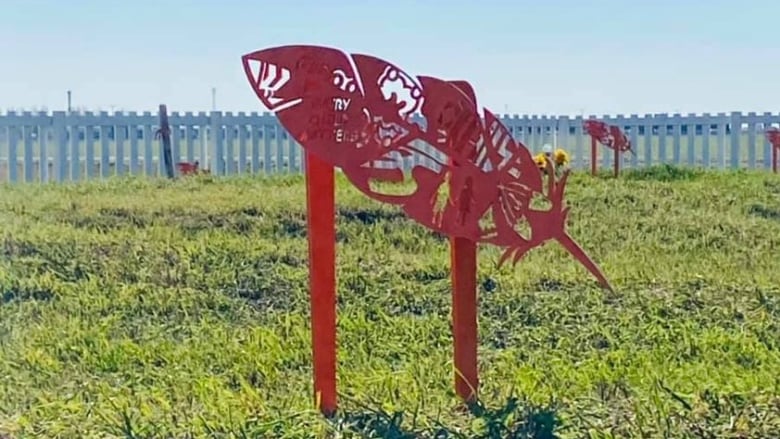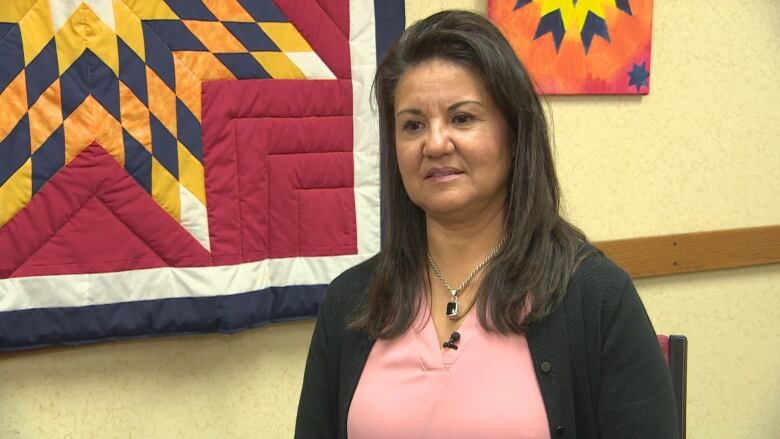After nearly a decade of work, 38 feathers now mark Regina Indian Industrial School cemetery graves
'Once the markers were up, it was a "wow, take a deep breath" moment': commemorative association president

Warning: This storycontains distressing details.
Sarah Longman has been seeking to honour the children buried at the Regina Indian Industrial School cemetery for nearly a decade.
This week, ahead of the inaugural National Day for Truth and Reconciliation, Longman watched as orange feathers, made from metal, were placed to mark the children buried there.
"Once the markers were up, it was a 'wow, take a deep breath' moment," said Longman, the President of the RIIS Commemorative Association Inc., a non-profit working toprotect the site of thecemeterywhere theschool once operated, just outside Regina.
"To have the actual physical markers identifying each of the spots, it was absolutely emotional and it caught me off guard."
Thirty-eight metal markers, donated by Pasqua First Nation and Pro Metal Industries, were placed at the site by descendants of the children who were forced to attend the Regina Indian Industrial School.

The non-profit association has been using ground-penetrating radar to search for graves at the site since 2012. The human-made disturbances that werefound, which could be an indication of graves, were finally marked this week.
"It's almost like it moved from being invisible to being completely visible," said Longman.
"And it just kind of does something to you when you see the number of markers out there and kind of how they're situated. It's an absolutely fantastic gesture, but a very realistic, almost haunting image to see them spread out through the white picket fence."
The Regina Indian Industrial School was builtabout six kilometres outside the city. It operated from 1891 to 1910 and was run by the Presbyterian Church of Canada.
All that remains of the schoolis the cemetery, which was used as farmland until it was recovered in 2011 and the commemorative association began its work.
'Long time coming'
The cemetery was designated a heritage site by the province in 2017. Two years later the land was transferred by the federal government to theRIIS Commemorative Association.
Longman has been motivated over the decade by her passion to educate others about the history of the residential school,including non-Indigenous people and those who are descendants of the peopleforced to attend residential schools.
She says she gets calls often from people trying to find out whether their grandparents were at the Regina Indian Industrial School. She looks up their names on a registry from the school.
"It's certainly heartfelt work. It's passionate work, it's legacy work," said Longman.
She says she hopes that when people visit the cemetery they reflect on the country's collective history and educate themselves about what happened at the Regina site and all residential schools.

"I sincerely hope thatcemetery and every other cemetery that's yet to be discovered is never, ever forgotten or hidden from everybody," she said.
"This history needs to be uncovered. It needs to be shared and it needs to be accepted. And we need to find ways to do that together as Canadians."
While there are now markers at the cemetery, the association'swork is not done.
Longman continues to support First Nations communities that are beginning to recover their own residential school cemeteries, sharing the best practices she has learned over the past decade about recovering information and marking the graves.
"We found we're not done our work and even though we're 10 years into it, when we work with our First Nations communities, we always tell them this is a long journey," she said.
"Be prepared for a long journey. This is not a month or two months or even three months work. This is a long time coming."
Support is available for anyone affected by the lingering effects of residential school and those who are triggered by the latest reports.
A national Indian Residential School Crisis Line has been set up to provide support for residential school survivors and others affected. People can access emotional and crisis referral services by calling the 24-hour national crisis line: 1-866-925-4419.












_(720p).jpg)


 OFFICIAL HD MUSIC VIDEO.jpg)
.jpg)



























































































